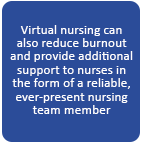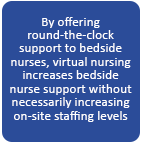Adding virtual nursing can change the way nursing care is delivered while maintaining the high level of patient care that health organizations strive to provide
Nurse shortages and demand are projected to persist nationwide. How do virtual nursing providers help hospitals adapt to staffing shortages and recruitment challenges? In what ways are they tailoring their services to meet the needs of hospitals and health systems?
 The issues driving the nursing shortage are not likely to be resolved quickly or easily. While the clinical need for nurses continues to grow, the supply continues to dwindle. Nurses are leaving the profession at an alarming rate, many due to burnout or retirement. The 2021 NSI National Health Care Retention & RN Staffing Report, drawing from data gathered in the first quarter of 2021, reported 35.8% of hospitals had a registered nurse vacancy rate above 10%. In addition, RN turnover rose in 2020 to 18.7%, an increase of almost 3 percentage points from 2019. And the Medscape Nurse Career Satisfaction Report 2021 indicated that more than a third of nursing respondents reported being “burned out” or “very burned out.”
The issues driving the nursing shortage are not likely to be resolved quickly or easily. While the clinical need for nurses continues to grow, the supply continues to dwindle. Nurses are leaving the profession at an alarming rate, many due to burnout or retirement. The 2021 NSI National Health Care Retention & RN Staffing Report, drawing from data gathered in the first quarter of 2021, reported 35.8% of hospitals had a registered nurse vacancy rate above 10%. In addition, RN turnover rose in 2020 to 18.7%, an increase of almost 3 percentage points from 2019. And the Medscape Nurse Career Satisfaction Report 2021 indicated that more than a third of nursing respondents reported being “burned out” or “very burned out.”
 Health systems have been forced to take unprecedented and sometimes drastic measures to maintain adequate staffing and safe patient care. Hospitals often resort to contracting large numbers of travel nurses, increasing patient-to-nurse ratios, and leaning more heavily on non-nursing support staff. These efforts, while potentially helpful in the short term, do not offer sustainable long-term solutions.
Adding virtual nursing as part of the patient care team can change the way nursing care is delivered while maintaining the high level of patient care we all strive to provide. Virtual nursing uses technology to enable skilled off-site nurses to perform nursing tasks that do not require physical presence. This allows the on-site nursing team to spend more time at the bedside and focus on hands-on patient care. Examples of the work that can be managed virtually include admission and discharge documentation, patient and family education, medication reconciliation, patient monitoring, supporting bedside preceptors and much more.
Effective virtual nursing care requires the understanding that there is not likely to be a single set of virtual nursing tasks and workflows that will work across a range of facilities and situations. Instead, the service should be designed with the flexibility to complement the mix of skills present in the bedside team and address the distinct set of challenges a hospital or system identifies. When defined and delivered successfully, virtual nursing utilizes a team concept that leverages the skills and experience of the collective nursing team – incorporating both telemedicine and bedside skills.
Health systems have been forced to take unprecedented and sometimes drastic measures to maintain adequate staffing and safe patient care. Hospitals often resort to contracting large numbers of travel nurses, increasing patient-to-nurse ratios, and leaning more heavily on non-nursing support staff. These efforts, while potentially helpful in the short term, do not offer sustainable long-term solutions.
Adding virtual nursing as part of the patient care team can change the way nursing care is delivered while maintaining the high level of patient care we all strive to provide. Virtual nursing uses technology to enable skilled off-site nurses to perform nursing tasks that do not require physical presence. This allows the on-site nursing team to spend more time at the bedside and focus on hands-on patient care. Examples of the work that can be managed virtually include admission and discharge documentation, patient and family education, medication reconciliation, patient monitoring, supporting bedside preceptors and much more.
Effective virtual nursing care requires the understanding that there is not likely to be a single set of virtual nursing tasks and workflows that will work across a range of facilities and situations. Instead, the service should be designed with the flexibility to complement the mix of skills present in the bedside team and address the distinct set of challenges a hospital or system identifies. When defined and delivered successfully, virtual nursing utilizes a team concept that leverages the skills and experience of the collective nursing team – incorporating both telemedicine and bedside skills.
What are some key benefits of virtual nursing? Why has interest grown so quickly?
Virtual nursing effectively augments the hospital’s nurse staffing immediately and reassigns some key nursing tasks to the virtual nurse. It can add nursing capacity quickly without the need to pay for travel nurses, recruit new staff or relocate nurses. One of the key clinical benefits of virtual nursing is its ability to absorb some time-intensive tasks, protecting the effectiveness of the in-hospital team. For example, a floor nurse handling a patient’s discharge and the associated documentation might be unavailable to their other patients for 30 to 45 minutes. The availability of virtual nursing staff to handle time-consuming tasks like this allows the bedside nurse to keep their focus on hands-on patient care and other tasks that can only be done in person, such as administering medication or performing a physical assessment. The enhanced bedside efficiency provides the opportunity for improved patient care and outcomes.
In addition, virtual nursing can reduce burnout of, and provide additional support to, nurses in the form of a reliable, ever-present nursing team member. The bedside nurse can count on experienced telemedicine nurses to collaborate as needed on specific procedures, participate in the plan of care, or attentively monitor a workflow checklist.
One of the key clinical benefits of virtual nursing is its ability to absorb some time-intensive tasks, protecting the effectiveness of the in-hospital team. For example, a floor nurse handling a patient’s discharge and the associated documentation might be unavailable to their other patients for 30 to 45 minutes. The availability of virtual nursing staff to handle time-consuming tasks like this allows the bedside nurse to keep their focus on hands-on patient care and other tasks that can only be done in person, such as administering medication or performing a physical assessment. The enhanced bedside efficiency provides the opportunity for improved patient care and outcomes.
In addition, virtual nursing can reduce burnout of, and provide additional support to, nurses in the form of a reliable, ever-present nursing team member. The bedside nurse can count on experienced telemedicine nurses to collaborate as needed on specific procedures, participate in the plan of care, or attentively monitor a workflow checklist.
Burnout and attrition are major issues in health care, and nurses and nursing staffs are not immune. In what ways can virtual nursing help combat burnout and attrition?
The Medscape report I mentioned earlier makes clear the impact of burnout and attrition on nurses — and the health systems that employ them. Virtual nursing provides an important tool to systems and nurses to help address these issues. By offering round-the-clock support to bedside nurses, virtual nursing increases bedside nurse support without necessarily increasing on-site staffing levels, which might not be possible or may bring unsustainable associated costs. Bedside nurses can turn to a virtual nurse for coaching on an unfamiliar procedure, a readily available second opinion, or the opportunity to hand off a task while they attend to the needs of their other patients. Virtual nursing technology can also be deployed in a manner that helps ensure consistency in the application of prescribed workflows, adding to the safety-net effect provided by virtual nursing.What challenges arising from the pandemic are here to stay, and how can virtual nursing solutions help mitigate them?
 The steep case volume spikes from the pandemic vividly illustrated the need to be able to anticipate and have solutions in place that are capable of flexing healthcare resources to meet rapid variations. For many regional systems, this proved challenging because most, and sometimes all, of their hospitals were in the same region and faced volume challenges at the same time. They simply were not able to draw upon clinical capacity in unaffected parts of their system, whether that was done virtually or by relocating staff temporarily. As healthcare facilities rethink the delivery of nursing services, a customizable virtual nursing component will be an increasingly important strategic capability.
The pandemic also created the realization that clinical expertise could be delivered anywhere and at any time, regardless of patient and clinician locations. The ability of telemedicine to deliver appropriate care anywhere will be a lasting legacy of the pandemic, as will patient expectation of such care. Forward-looking health systems are developing telemedicine capabilities that aim to leverage top-of-license utilization of clinicians, whether those clinicians are staffed within the system or by a partner. Virtual nursing is one of those solutions.
A decreasing supply of new graduates, more nurses retiring or leaving the profession for other career avenues, and increased nursing burnout have all contributed to the nursing shortage. It is no surprise that the pandemic amplified the shortage and its impact. As nurses and other clinical leaders began to explore options to help alleviate the stress on our healthcare system, one option in particular began to shine: virtual nursing. By utilizing technology and partnering with experienced telemedicine providers, hospitals were able to develop reliable, flexible and clinically responsive patient care solutions in a short amount of time. The success of other telemedicine solutions over the past two years and health systems’ familiarity with them also advanced the consideration of virtual nursing.
The steep case volume spikes from the pandemic vividly illustrated the need to be able to anticipate and have solutions in place that are capable of flexing healthcare resources to meet rapid variations. For many regional systems, this proved challenging because most, and sometimes all, of their hospitals were in the same region and faced volume challenges at the same time. They simply were not able to draw upon clinical capacity in unaffected parts of their system, whether that was done virtually or by relocating staff temporarily. As healthcare facilities rethink the delivery of nursing services, a customizable virtual nursing component will be an increasingly important strategic capability.
The pandemic also created the realization that clinical expertise could be delivered anywhere and at any time, regardless of patient and clinician locations. The ability of telemedicine to deliver appropriate care anywhere will be a lasting legacy of the pandemic, as will patient expectation of such care. Forward-looking health systems are developing telemedicine capabilities that aim to leverage top-of-license utilization of clinicians, whether those clinicians are staffed within the system or by a partner. Virtual nursing is one of those solutions.
A decreasing supply of new graduates, more nurses retiring or leaving the profession for other career avenues, and increased nursing burnout have all contributed to the nursing shortage. It is no surprise that the pandemic amplified the shortage and its impact. As nurses and other clinical leaders began to explore options to help alleviate the stress on our healthcare system, one option in particular began to shine: virtual nursing. By utilizing technology and partnering with experienced telemedicine providers, hospitals were able to develop reliable, flexible and clinically responsive patient care solutions in a short amount of time. The success of other telemedicine solutions over the past two years and health systems’ familiarity with them also advanced the consideration of virtual nursing.
How can virtual nurses reduce the burden on bedside nurses?
To some degree, the impact of virtual nursing on bedside nurses is linear. Each task that a virtual nurse can accomplish removes a task from the to-do list of a bedside nurse. When designed and implemented correctly, virtual nursing reduces the burden on and improves patient care for bedside nurses in at least two additional ways. First, virtual nursing enables the bedside nurse to stay focused on hands-on care by offloading a variety of potentially distracting activities. This can improve patient satisfaction and clinical results by allowing the bedside nurse in-person opportunities to identify additional care needs. In addition, virtual nursing can also reduce burnout and provide additional support to nurses in the form of a reliable, ever-present nursing team member. The bedside nurse can count on experienced telemedicine nurses to collaborate as needed on specific procedures, participate in the plan of care, or attentively monitor a workflow checklist.How do hospitals and health systems determine when and why to partner with a virtual nursing provider?
The decision to work with a virtual nursing partner is sometimes driven by capacity considerations: the telemedicine provider can offer virtual nursing capacity quickly, whereas the system would have to recruit and train staff. In our own experience, we were able to partner with a system to implement a virtual nursing solution within a few weeks of our first conversation. The client understood that recruiting a similar team within their competitive geographic area would be extremely difficult and could potentially pull more nurses in their geographic area away from the bedside, which they could not afford. Educated by their telemedicine experiences of the past two years, innovative systems might choose to turn to an experienced telemedicine provider rather than undertake the development challenge themselves. The partner should be able to provide experience drawn from a range of client relationships and the flexibility to adapt recommended workflows to the needs of the system, ideally with technology that helps smoothly implement, customize, and manage workflows at the system, hospital or unit level. Marcia Murphy brings 20 years of experience as a nurse and nurse practitioner in bedside, telemedicine and leadership roles to her position at Hicuity Health. As vice president of clinical operations and nursing, Murphy leads operations across twelve care operations centers with responsibility for staffing, workflow definition and compliance, and operations management. Visit hicuityhealth.com to learn more. This article was originally published in ANA SmartBrief March 29,2022


